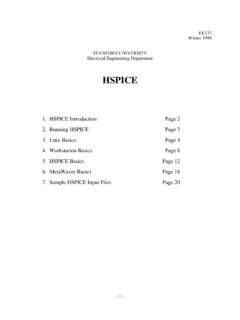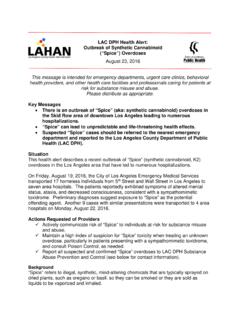Transcription of SPICE ‘Quick’ Reference Sheet THE GENERAL …
1 EE133 Winter 20011 SPICE quick Reference Sheet quick Reference SheetTHE GENERAL ANATOMY OF A SPICE DECKSPECIFYING circuit topology : data STATEMENTSB asic ComponentsResistorsCapacitors and InductorsVoltage and Current SourcesIndependent DC SourcesIndependent AC SourcesTransient SourcesSinusoidal SourcesPiecewise Linear Source (PWL)PulseDependent SourcesSemiconductor DevicesDiodeBipolar TransistorMOSFETI deal Operational AmplifiersSubcircuitsSPECIFYING ANALYSIS: CONTROL STATEMENTSO perating Point (.OP)DC Statement (.DC)AC Analysis (.AC)Transient (.TRAN)Initial Conditions (.IC)Transfer Function (.TF)LOOKING AT YOUR data : OUTPUT STATEMENTSO utput to your *.lis or *.lst file (.PRINT and .PLOT)Outputting to MWaves/AWaves (.OPTION POST)Searching for a Value (.)
2 MEASURE)EE133 Winter 20012 SPICE quick Reference Sheet GENERAL ANATOMY OF A SPICE DECKSPICE input file, called source file, consists of three parts. First, data Statementsdescribe the components and the interconnections. Then, Control Statements tell SPICE what type of analysis to perform on the circuit . Finally, Output Statements specify whatoutputs are to be printed or these statements may appear in any order, it is recommended that they be givenin the above sequence. Two other statements are required: the title statement and the endstatement. The title statement is the first line and can contain any information, while theend statement is always .END. This statement must be a line by itself, followed by acarriage return! In addition, you can insert comment statements, which must begin withan asterisk (*) and are ignored by SPICE .
3 TITLE STATEMENT ELEMENT STATEMENTS . COMMAND (CONTROL) STATEMENTS OUTPUT STATEMENTS .END <CR>The statements have a free format and consist of fields separated by a blank. If one wantsto continue a statement to the next line, one uses a "+" sign (continuation sign) at thebeginning of the next line. Numbers can be integers, or floating points. For example, RES1 1 0 3500 or RES1 1 0 can also use the following scale factors:SuffixScaleTE+12 1,000,000,000,000 TeraGE+09 1,000,000,000 GigaX or MEGE+06 1,000,000 MegaKE+03 1,000 KiloME-03 MilliUE-06 MicroNE-09 NanoPE-12 PicoFE-15 FemtoBoth upper and lower case letters are allowed in HSPICE ( SPICE uses only uppercasecharacters).
4 So could specify a capacitor of 225 picofarad in the following ways: 225P, 225p, 225pF; 225pFarad; 225E-12; , Winter 20013 SPICE quick Reference Sheet Basic ComponentsResistorsRname N+ N- Value N+ represents the positive terminal, N represents the negative terminal. Value is the resistance value The ultimate in and CapacitorsCname N+ N- Value <IC=Initial Condition>Lname N+ N- Value <IC=Initial Condition> IC is the initial condition (DC voltage for capacitors or DC current for inductors). Itis optional The symbol < > means that the field is optional. If not specified, it is assumed to bezero. In case of an inductor, the current flows from N+ to and Current Sources:Independent DC SourcesVoltage source: Vname N+ N- <DC=> DCValueCurrent source: Iname N+ N- <DC=> DCValue N+ is the positive terminal N is the negative terminal DCValue gives the value of the source The name of a voltage and current source must start with V and I, AC SourcesVoltage source: Vname N+ N- AC ACValue, PhaseCurrent source.
5 Iname N+ N- AC ACValue, Phase N+ is the positive terminal N is the negative terminal ACValue gives the value of the source ACPhase gives the phase in degrees The name of a voltage and current source must start with V and I, Winter 20014 SPICE quick Reference Sheet SourcesSinusoidalVname N+ N- SIN(VO VA fo <TD> <a> <PHASE>) Vname = VO + VA exp[-a.(t - TD)] sin[ (t - TD) + (PHASE/360)] VO - offset voltage in volts. VA - amplitude in volts. fo -the frequency in hertz. TD - delay in seconds a - damping factor per second Phase - phase in degrees (If TD, a and PHASE are not specified, it is assumed to be zero.) A cosine can be generated by shifting a sin by 90 degreesPiece-Wise LinearVname N+ N- PWL(T1 V1 T2 V2 T3 V3 .. Tn Vn) (Ti Vi) specifies the value Vi of the source at time TiEE133 Winter 20015 SPICE quick Reference Sheet N+ N- PULSE(Vo V1 Td Tr Tf Tw To) Vo - initial voltage V1 - peak voltage Td - initial delay time Tr - rise time Tf - fall time Tw - pulse-width To - period of waveDependent SourcesVoltage controlled voltage source: Ename N+ N- NC1 NC2 ValueVoltage controlled current source: Gname N+ N- NC1 NC2 ValueCurrent controlled voltage source: Hname N+ N- Vcontrol ValueCurrent controlled current source: Fname N+ N- Vcontrol Value N+ and N- are the positive and negative terminals of the dependent source,respectively.
6 NC1 and NC2 are the positive and negative terminals of the controlling voltagesource, respectively. Vcontrol is the zero value voltage source used to measure the controlling current(the positive current flows into the positive terminal of the controlling voltagesource!). Value is a multiplier value. In math terms: Value*(NC1-NC2)=(N+ N )EE133 Winter 20016 SPICE quick Reference Sheet DevicesDiodeElement line (What appears in your circuit )Dname N+ N- MODNameModel statement: (Appears in your deck to describe circuit element).MODEL MODName D (IS= N= Rs= CJO= Tt= BV= IBV=).model D1N4148 D (IS= , RS=16 CJO=2PF TT=12N BV=100 IBV= ) The element name starts with D to indicate that the element is a diode, N+ is the positive end and N- is the negative end (where the arrow points) MODName is the name of the model of the diode specified in the model line.
7 IS - saturation current, (default=1E-14A), N - the emission coefficient, (=1), RS - the series resistance, (=0 ohm), CJO - junction capacitance, (=0F), TT - transit time, (=0sec), BV - reverse bias breakdown voltage, (=infinite) and IBV - the reverse bias breakdown current, (=1xE-10A).If a parameter is not specified the default value (given in parenthesis) is TransistorElement: (BASIC MODEL)Qname C B E BJT_modelNameModel statement: .MODEL BJT_modName NPN (BF=val IS=val VAF=val).MODEL BJT_modName PNP (BF=val IS=val VAF=val).model Q2N2222A NPN (IS= XTI=3 EG= VAF= BF= ISE= IKF=.2847 XTB= BR= NC=2 ISC=0 IKR=0 RC=1 CJC= MJC=.3416 VJC=.75 FC=.5 CJE= MJE=.377 VJE=.75TR= TF= ITF=.6 VTF= XTF=3 RB=10) BF is the common emitter current gain , IS is the saturation current VAF is the Early voltage.
8 If no values are specified, the default values are assumed ( =100; IS=1E-16A, andVAF=[infinite]). As an example, the model parameters for the 2N2222A NPN transistor is givenabove. As you can see, there are many other parameters that can be specified. Amore detailed list can be found in the SPICE manualEE133 Winter 20017 SPICE quick Reference Sheet : (BASIC MODEL)Mname ND NG NS <NB> ModName <L=VAL> <W=VAL>Model:.MODEL ModName NMOS (<LEVEL=val> <keyname=val> .. ).MODEL ModName PMOS (<LEVEL=val> <keyname=val> .. ) Like the BJT model, one can use a simplified circuit call, and simply specify widthand length. The model being called will have additional parameters already this class, you will not have to worry about the modeling Operational AmplifiersWe ve actually already seen this!
9 An op-amp can be modeled as a voltagecontrolled voltage source. Look back to the Dependent Sources section and seehow you can match the leads what if you want a realistic op-amp model? That s where subcircuits becomeuseful. SPICE allows you to define a collection of elements as a subcircuit ( operational amplifier) and to insert this description into the overall circuit (asyou would do for any other element).Defining a subcircuit A subcircuit is defined by a .SUBCKT control statement, followed by the circuitdescription as follows: .SUBCKT SUBNAME N1 N2 N3 .. Element statements ..ENDS SUBNAMEin which SUBNAME is the subcircuit name and N1, N2, N3 are the externalnodes of the subcircuit. The external nodes cannot be 0. The node numbersused inside the subcircuit are strictly local, except for node 0 which is Winter 20018 SPICE quick Reference Sheet a subcircuitThe element statement for a subcircuit is similar to any other element.
10 The formatis as follows: Xname N1 N2 N3 .. SUBNAMEin which Xname refers to the element (subcircuit) being used; N1, N2, N3 are thenodes to which the external nodes of the subcircuit are being connected,and SUBNAME is the name of the subcircuit being used. An example of an inverting opamp circuit using the subcircuit of the uA741 (seeoperational amplifiers above) is given below. The subcircuit is called x1. vs 1 0 dc 5 r1 1 2 200 rf 2 3 1k x1 0 2 3 opamp741 .dc vs 0 10 1 .plot dc v(3) .endEE133 Winter 20019 SPICE quick Reference Sheet ANALYSIS: CONTROL STATEMENTSBy now you should have a basic understanding of the vocabulary SPICE uses to describethe physical circuit . Now we turn to StatementThis statement instructs SPICE to compute the DC operating points: voltage at the nodes current in each voltage source operating point for each elementHSpice does not give the DC voltages unless you have specified a certain analysistype, such as.



















